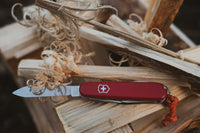Pocket Knife Blade Finishes & Coatings Explained
Key Takeaways
- Blade finishes and coatings enhance appearance, durability, and corrosion resistance.
- The most common types of blade finishes are mirror polish, satin, stonewash, and bead-blasted.
- The most common types of blade coatings are Cerakote and black oxide.
- Customize a high-quality pocket knife at Palmetto Wood Shop.
Folding knives should last a lifetime and stay in the family for generations. Knife manufacturers recognize the importance of longevity, which is why they use specialized finishes and coatings to improve the durability and corrosion resistance of their blades.
Of course, knife blade finishes are used to enhance eye appeal, too. Knife owners form a deep connection to their everyday carry, so of course, they want it to look great! Coatings and finishes add that extra touch of style that makes an ordinary blade special.
Here’s everything you need to know about the most common types of finishes and coatings.
What’s the Difference Between a Finish and a Coating?
Finish:
A finish is when the manufacturer uses a specific process, such as sanding, grinding, or tumbling, to change the surface of the metal itself. The blade is still just the raw metal, but its texture and appearance have been altered. Knife blade finishes don’t have any new materials added.
Coating:
Knife blade coatings are special materials that are applied to the metal. The coatings are typically for adding strength, hardness, and corrosion resistance to the blade, as well as for reducing glare and giving the blade a unique style.
Common Types of Blade Finishes & Coatings
It’s worth noting that some knife manufacturers have their own proprietary finishes and coatings. In this guide, we’re covering the most widespread types you’re likely to find across most brands.
Mirror Polish Finish
As the name implies, mirror-polished blades have a brilliant, high-shine appearance similar to a mirror (although not quite as reflective). These knife blade finishes require a great deal of polishing and buffing to transform the raw metal into such a smooth and shiny blade.
The most obvious benefit of the mirror polish finish is its stunning eye appeal. With that said, they do show fingerprints, smudges, and scratches more easily, but many knife owners enjoy that look because it adds one-of-a-kind character to the blade.
Beyond the look, mirror-polished blades are exceptionally resistant to corrosion because the smooth finish significantly reduces the porousness of the blade, making it extremely difficult for moisture and contaminants to cling.
Our Recommendations:
Although many knife manufacturers offer mirror-polished knife blade finishes, Victorinox Swiss Army Knives and Case Tru-Sharp™ stainless steel blades are especially known for their brilliance.
Cerakote Coating

Cerakote is one of the most popular types of knife blade coatings because of its outstanding protection. It’s a special type of ceramic that’s baked onto the blade, offering incredible hardness, strength, and resistance to corrosion, UV light, chemicals, saltwater, and other environmental damage.
Unsurprisingly, Cerakote-coated blades are very popular among individuals who require the most durable hunting knives or tactical knives for demanding applications in outdoor environments.
Our Recommendation:
The Kershaw Leek 1660CKT is a great option for anyone seeking a tough, cerakote-coated blade.
Satin Finish

Satin knife blade finishes offer a classic middle ground between raw metal and mirror polish. Satin-finished blades have the classic look of real, no-frills metal without the high shine. The no-glare look is achieved by grinding the blade in one direction to create fine lines that run uniformly across the blade.
In addition to the classy appearance, this type of finish is beneficial because it helps to seal micro-pores that could lead to corrosion. However, it doesn’t seal quite as tightly as the mirror finish.
Our Recommendation:
Bear & Son Cutlery and Buck Knives are both known for producing superb blades with satin finishes.
Stonewash Finish
Stonewash knife blade finishes have a worn-in, textured look that doesn’t shy away from “imperfections.” The finish is achieved by tumbling the blade with abrasives. The look can vary widely from a slight matte texture that’s difficult to detect to a heavily worn and even uneven blade.
Stonewashed blades are naturally great at hiding wear and tear, so they’re perfect for someone who prefers low-maintenance knives. Each blade has its own unique look, adding to the overall appeal.
Our Recommendation:
The Kershaw Leek 1660SWBLK has a tasteful stonewash-finished blade.
Black Oxide Coating
Black oxide knife blade coatings are achieved through a chemical conversion process that turns the surface of the metal into magnetite, creating a protective coating. Often used by military personnel who require low-profile knife blade finishes, the black color reduces glare and improves stealth.
Our Recommendation:
Smith & Wesson knives often feature black oxide coatings. The M&P Spear Tip OTF and Extreme Ops SWA24S are both excellent examples of the style.
Bead-Blasted Finish
As you probably guessed, this type of finish is achieved by blasting the blade with beads, which are typically made from ceramic or glass. The look and texture are typically like a cross between satin and stonewash. It’s a classy, smooth, matte style that reduces glare while keeping the natural metal look intact.
Our Recommendation:
The Kershaw Scallion 1620NB has a top-tier bead-blasted finish.
Order Custom Pocket Knives Today
If you have any questions about knife blade finishes, or if you’re looking for a blade with a specific type of coating, get in touch. Shop our customizable pocket knives now, and add a personal touch with a laser-engraved message!











